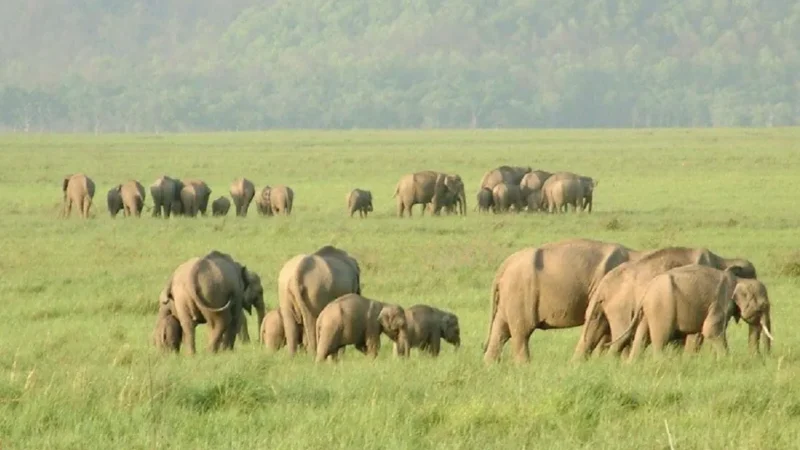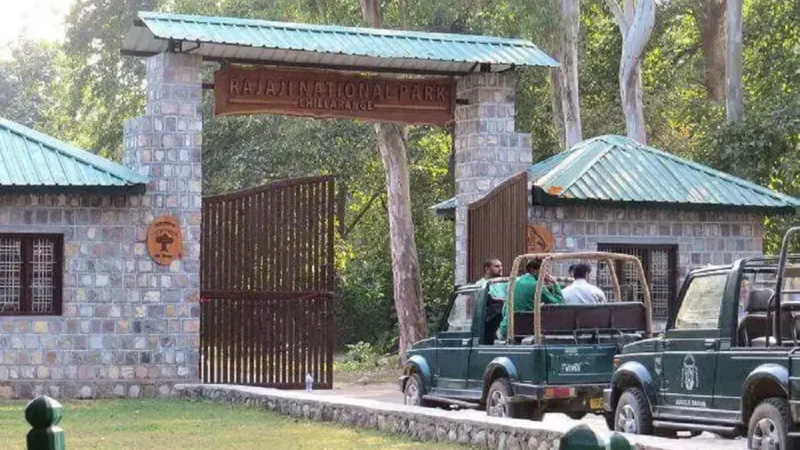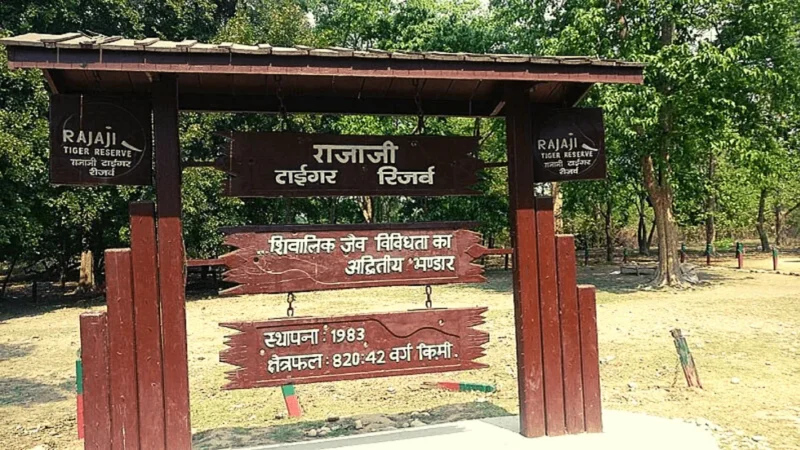Safari at Rajaji National Park: A Wildlife Adventure Like No Other

Table of Contents
ToggleSafari at Rajaji National Park -
Embark on a thrilling adventure into the heart of nature as we introduce you to the exciting world of safari at Rajaji National Park. Located in the scenic state of Uttarakhand, India, Rajaji National Park is a sanctuary for wildlife enthusiasts and nature lovers. Spread over a vast area, the park is renowned for its rich biodiversity, encompassing lush forests, flowing rivers, and a diverse range of animal and bird species.
A safari in Rajaji National Park offers an opportunity to explore the park’s pristine wilderness and witness the wonders of the natural world up close. Whether you’re a wildlife enthusiast or simply seeking a unique and immersive experience in nature, a safari in Rajaji National Park promises to be a memorable journey.
Venture deep into the park’s dense jungles aboard an open jeep or an elephant-back safari, and get ready to encounter majestic animals in their natural habitat. Keep your eyes peeled for the iconic Bengal tiger, the regal Asian elephant, the elusive leopard, and many other fascinating wildlife species. Rajaji National Park never fails to delight nature enthusiasts, from spotted deer and wild boar to langurs and colorful bird species.
With diverse safari options, you can customize your experience based on your preferences and interests. Opt for a morning safari to witness the park awakening to the sights and sounds of nature, or embark on an evening safari to witness the mesmerizing sunset hues painting the landscapes. Night safaris are also available for those exploring the park after dark and catching glimpses of nocturnal creatures.
To ensure a seamless safari experience, it is advisable to book your safari in advance and follow the park’s regulations and guidelines. Experienced safari guides accompany you during the expedition, offering valuable insights into the park’s ecology, pointing out hidden treasures, and ensuring your safety throughout the journey.
Beyond the captivating wildlife, a safari at Rajaji National Park allows you to immerse yourself in the breathtaking landscapes and serene surroundings. From the gushing rivers to the dense forests, every moment spent in the park is an opportunity to connect with nature and appreciate its boundless beauty.
Join us as we delve into the safari world at Rajaji National Park, providing valuable information, tips, and recommendations to enhance your safari experience. Prepare for an unforgettable adventure as you venture into the wild, creating memories that will last a lifetime in the captivating realm of Rajaji National Park.
Wildlife Encounters: Spotting Majestic Animals on Safari -
Embarking on a safari at Rajaji National Park is an exciting opportunity to witness the majestic animals that call this protected area home. With its diverse ecosystems and abundant wildlife, the park offers an incredible chance to observe these magnificent creatures in their natural habitat. Here are some of the majestic animals you may encounter during your safari:
- Bengal Tiger: The iconic Bengal tiger is the crown jewel of Rajaji National Park. While spotting a tiger in the wild requires luck and patience, the park is known for its healthy tiger population. Keep your eyes peeled and listen for the alarm calls of other animals, as they may indicate the presence of this elusive predator.
- Asian Elephant: Rajaji National Park is renowned for its population of Asian elephants. These gentle giants roam freely in the park’s forests and grasslands. Spotting these magnificent creatures during a safari is a truly awe-inspiring experience, especially when you witness them in their natural habitat, socializing in herds, or feeding near water bodies.
- Leopard: Known for their stealth and elusive nature, leopards are another exciting species to look out for. Rajaji National Park is home to a significant population of leopards, although they are masters of camouflage. Keep a keen eye on tree branches or rocky outcrops, as leopards often seek refuge in these elevated spots.
- Spotted Deer: Also known as chital or cheetal, spotted deer are one of the most commonly sighted animals in Rajaji National Park. These graceful creatures with distinctive white spots on their reddish-brown coats create a mesmerizing sight as they graze in the grasslands or move through the forest.
- Wild Boar: The wild boar, with its stout body and curved tusks, is a common sight in the park. These robust creatures forage for food in the undergrowth and can often be seen in small family groups. Their grunting calls and distinctive appearance add to the unique wildlife encounters on a safari.
- Langurs: Rajaji National Park is home to Hanuman langurs, a species of monkeys known for their black faces and long tails. These agile creatures can be seen swinging through the trees or perched on tree branches, keeping a close watch on their surroundings. Their presence adds an element of liveliness to the park’s biodiversity.
- Bird Species: Rajaji National Park is a haven for birdwatchers, boasting various avian species. Keep your binoculars handy to spot colorful birds such as the great hornbill, crested serpent eagle, pied kingfisher, and many more. The park’s diverse habitats attract resident and migratory bird species yearly.
Remember, wildlife encounters are a combination of luck and patience. While the park teems with wildlife, respecting their space and maintaining a safe distance is essential. Safaris are typically conducted with trained guides with in-depth knowledge of the park and its inhabitants, increasing your chances of spotting these majestic animals.
Capture these extraordinary moments on camera, but also take the time to immerse yourself in the beauty of the surroundings. Listen to the calls of the wild, breathe in the fresh air, and appreciate the privilege of witnessing these majestic animals thriving in their natural habitat during your safari at Rajaji National Park.
Safari Options: Exploring Rajaji National Park's Breathtaking Landscapes
Rajaji National Park is a treasure trove of natural beauty and diverse landscapes. To fully immerse yourself in the park’s breathtaking surroundings, various safari options allow you to explore different parts of the park. Here are some of the safari options to consider when planning your visit to Rajaji National Park:
- Jeep Safari: Jeep safaris are the most popular and common way to explore Rajaji National Park. Board an open jeep with a trained guide and traverse the park’s rugged terrains, dense forests, and grasslands. Jeep safaris provide a comfortable and convenient way to cover larger park areas and increase your chances of wildlife sightings. The jeeps are equipped with safety measures and offer an unobstructed view of the surroundings.
- Elephant Safari: For a truly unique and memorable experience, opt for an elephant safari. Riding atop these gentle giants allows you to venture deep into the park’s wilderness, accessing areas that may be challenging to reach by other means. Elephant safaris offer a different perspective and allow you to observe wildlife from a higher vantage point. It’s a slower-paced safari providing a more immersive experience with nature.
- Canter Safari: Canter safaris are larger open vehicles that accommodate more people. They are ideal for group tours and provide an opportunity to explore the park’s landscapes together. Canter safaris are often conducted along predetermined routes and offer a comfortable way to enjoy the wildlife and scenic beauty of Rajaji National Park.
- Nature Walks: While not a traditional safari option, guided nature walks are a fantastic way to explore the park on foot. Accompanied by experienced naturalists or forest guides, you can delve deeper into the park’s ecosystems, learning about its flora, fauna, and intricate ecological processes. Nature walks allow you to connect with nature more intimately and offer birdwatching opportunities and observing smaller wildlife species.
- Birdwatching Safari: Rajaji National Park is a paradise for birdwatchers, with its rich birdlife and diverse habitats. Birdwatching safaris are specifically designed to spot and identify various bird species in their natural habitats. Accompanied by knowledgeable birding experts, you can navigate through the park’s trails and water bodies to catch glimpses of colorful and rare bird species. It’s an experience that will delight both avid birdwatchers and nature enthusiasts.
Each safari option offers a unique perspective on Rajaji National Park’s breathtaking landscapes. Whether you choose a jeep safari for wider coverage, an elephant safari for a close encounter with wildlife, or a nature walk to appreciate the finer details of nature, each option promises an unforgettable journey through the park’s enchanting wilderness.
Best Time for Safari: Seasons and Timings for Wildlife Sightings
When planning a safari at Rajaji National Park, timing is crucial to enhance your chances of witnessing wildlife in its natural habitat. Understanding the seasons and the optimal timings for wildlife sightings can greatly enhance your safari experience. Here are the best times for safari at Rajaji National Park:
- Winter (November to February): Winter is considered the peak season for safaris in Rajaji National Park. The weather is pleasant, with cooler temperatures and clear skies. During this time, animals are more active during the day, seeking water sources and enjoying the milder climate. The chances of spotting wildlife, including tigers and elephants, are higher this season. Early morning and late afternoon safaris are ideal for wildlife sightings, as animals are often more active during these cooler hours.
- Summer (March to June): The summer season in Rajaji National Park can be hot, but it offers unique experiences. This period is excellent for birdwatching, as many migratory birds visit the park during this time. The park’s lush greenery and blooming flora make for stunning landscapes. Morning safaris are recommended during the summer months to avoid the day’s peak heat. Wildlife sightings may be slightly reduced, as animals seek shade and water sources during the hotter hours.
- Monsoon (July to September): Rajaji National Park receives moderate to heavy rainfall during the monsoon season. The park remains closed for safaris during this period due to safety concerns and the potential disturbance to wildlife habitats. It is advisable to avoid planning a safari during the monsoon season, as access to the park may be limited, and wildlife sightings are unlikely.
It’s important to note that wildlife sightings depend on various factors, including animal behavior, vegetation density, and luck. While the recommended seasons offer higher chances of sightings, wildlife encounters are only sometimes guaranteed. Additionally, early morning and late afternoon safaris are generally more productive, as animals are most active.
Rajaji National Park Jeep Safari Charges -
The charges for a jeep safari at Rajaji National Park can vary depending on several factors, such as the duration of the safari, the number of people in the jeep, and whether you are an Indian or international visitor. While the exact charges may change over time, here is a general idea of the jeep safari charges at Rajaji National Park:
- Entry Fee: Every visitor entering Rajaji National Park is required to pay an entry fee. The fee varies for Indian nationals and foreign nationals. As of my knowledge cutoff in September 2022, the entry fee for Indian citizens is around INR 150 per person, while for foreign nationals, it is around INR 600 per person. These fees may be subject to change, so it’s advisable to check with the park authorities or your safari operator for the most up-to-date information.
- Jeep Rental: To go on a jeep safari, you must rent a jeep from authorized operators. The rental charges for a jeep may vary depending on the duration of the safari and the number of people sharing the jeep. Typically, the charges range from INR 1,500 to INR 4,000 per jeep for a safari of a few hours. It’s important to note that these charges are for the rental of the entire jeep so that the cost can be shared among the occupants.
- Guide Charges: It is mandatory to have a trained guide accompany you during the safari at Rajaji National Park. The guide charges are usually included in the overall safari package, but confirming this with your safari operator is advisable. The guide ensures your safety, provides valuable insights about the park and its wildlife, and enhances your safari experience.
- Other Charges: Besides the entry fee, jeep rental, and guide charges, there may be additional charges for camera permits or video camera permits if you plan to capture photos or videos during the safari. Again, these charges may vary, so it’s best to check with the park authorities or your safari operator for specific details.
Safari Guides: Enhancing Your Experience with Local Expertise
Having a knowledgeable and experienced safari guide can significantly enhance your wildlife experience when embarking on a safari at Rajaji National Park. Local safari guides provide valuable insights, strengthen your understanding of the park’s ecosystem, and help maximize your chances of wildlife sightings. Here are the reasons why safari guides are essential for an enriching experience:
- Expert Knowledge: Safari guides are well-versed in the flora, fauna, and ecosystems of Rajaji National Park. They possess in-depth knowledge about the park’s diverse wildlife, including their behaviors, habitats, and migration patterns. Their expertise allows them to spot and identify animals, birds, and other wildlife species that may be difficult for the untrained eye to detect. They can provide fascinating facts and anecdotes, giving you a deeper appreciation for the park’s biodiversity.
- Enhanced Wildlife Sightings: Safari guides instinctively understand animal movements and behavior. They know the best spots and timings for wildlife sightings based on their experience and regular interactions with the park’s inhabitants. They can interpret animal calls, track footprints, and navigate the park’s trails to increase your chances of encountering various wildlife species. With their guidance, you’ll be more likely to spot elusive animals such as tigers, leopards, and elephants.
- Safety and Security: Safety is of utmost importance during a safari. Safari guides are trained in wildlife behavior, safety protocols, and emergency procedures. They ensure you adhere to park regulations and maintain a safe distance from animals to prevent harm to wildlife and visitors. Their presence provides a sense of security, especially in close encounters with large animals, and allows you to enjoy the safari with peace of mind.
- Interpretation and Cultural Insights: Safari guides focus on wildlife and provide cultural and historical insights about the park and the local communities. They can share stories about the park’s conservation efforts, traditional practices, and the significance of Rajaji National Park in the local culture. This adds depth to your safari experience, allowing you to connect with the broader context of the park and its surroundings.
- Environmental Awareness and Conservation: Safari guides are crucial in promoting environmental awareness and conservation ethics. They educate visitors about the importance of preserving wildlife habitats, respecting wildlife, and minimizing our impact on the ecosystem. They encourage responsible behavior, such as proper waste disposal and adherence to park guidelines, ensuring a sustainable and eco-friendly safari experience.
When booking a safari, choose a reputable operator that employs trained and certified safari guides. Communicate your interests, preferences, and expectations to the safari guide, as they can customize the safari experience to align with your specific interests.
Beyond Wildlife: Other Attractions and Activities on Safari -
A safari at Rajaji National Park offers more than just wildlife encounters. While the main highlight is undoubtedly the park’s incredible biodiversity, several other attractions and activities can enhance your safari experience. Here are some of the additional attractions and activities you can enjoy during your safari at Rajaji National Park:
- Birdwatching: Rajaji National Park is a paradise for birdwatchers, boasting an affluent avian population with over 315 species of birds. From colorful resident birds to migratory species, the park offers ample opportunities for birdwatching. Keep your binoculars ready and be on the lookout for species like the great hornbill, white-rumped shama, pied kingfisher, and many more. The park’s varied habitats, including riverbanks, grasslands, and forests, attract a diverse range of birdlife.
- Nature Photography: The picturesque landscapes and abundant wildlife of Rajaji National Park provide fantastic opportunities for nature photography. Capture stunning shots of majestic elephants, elusive tigers, vibrant birds, and the park’s breathtaking scenery whether an amateur or a seasoned photographer, the park’s natural beauty will inspire you to capture the perfect shot.
- Nature Walks: Take a break from the jeep safari and embark on a guided nature walk to explore the park on foot. Accompanied by an experienced naturalist or forest guide, you can immerse yourself in the park’s smaller wonders. Observe the intricate details of the flora, learn about medicinal plants, and spot smaller wildlife species that are often missed during a jeep safari. Nature walks allow for a more intimate connection with the park’s ecosystems and offer a peaceful and immersive experience.
- Riverside Picnics: Rajaji National Park is blessed with beautiful rivers and streams flowing through its forests. Many safari operators offer the option of a riverside picnic during your safari. Take a break from wildlife spotting and enjoy a serene picnic along the banks of the river. It’s a perfect opportunity to relax, soak in the natural surroundings, and indulge in some delicious food amidst the tranquil ambiance of the park.
- Nature Interpretation Centers: Rajaji National Park has nature interpretation centers that provide information about the park’s flora, fauna, and conservation efforts. These centers offer educational displays, interactive exhibits, and audio-visual presentations that help visitors understand the park’s biodiversity and the importance of conservation. Exploring these centers can further deepen your knowledge and appreciation for the natural wonders of Rajaji National Park.
Remember to respect the park’s rules and regulations, maintain a safe distance from wildlife, and follow your safari guide’s or park authorities’ instructions during all activities. By engaging in these additional attractions and activities, you can maximize your safari experience at Rajaji National Park and create lasting memories of this remarkable natural haven.




